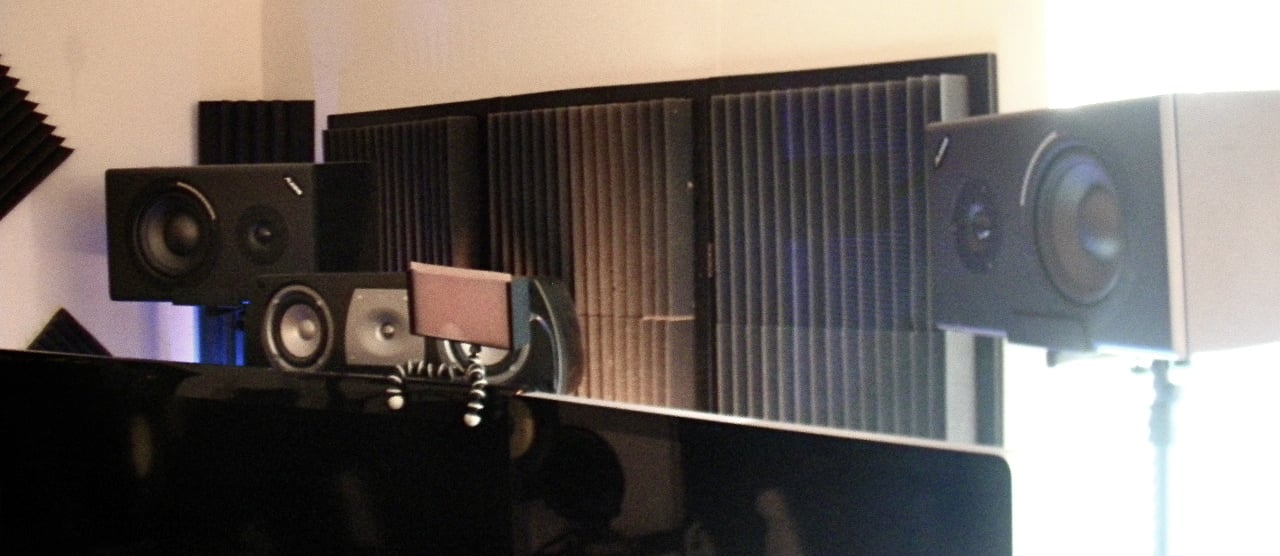Speaker/monitor Placement?, Where are yours? |
|
|
|
|
|
| Mar 15 2012, 03:35 AM |
|
On either side of my desk, vertically.
Attached image(s)
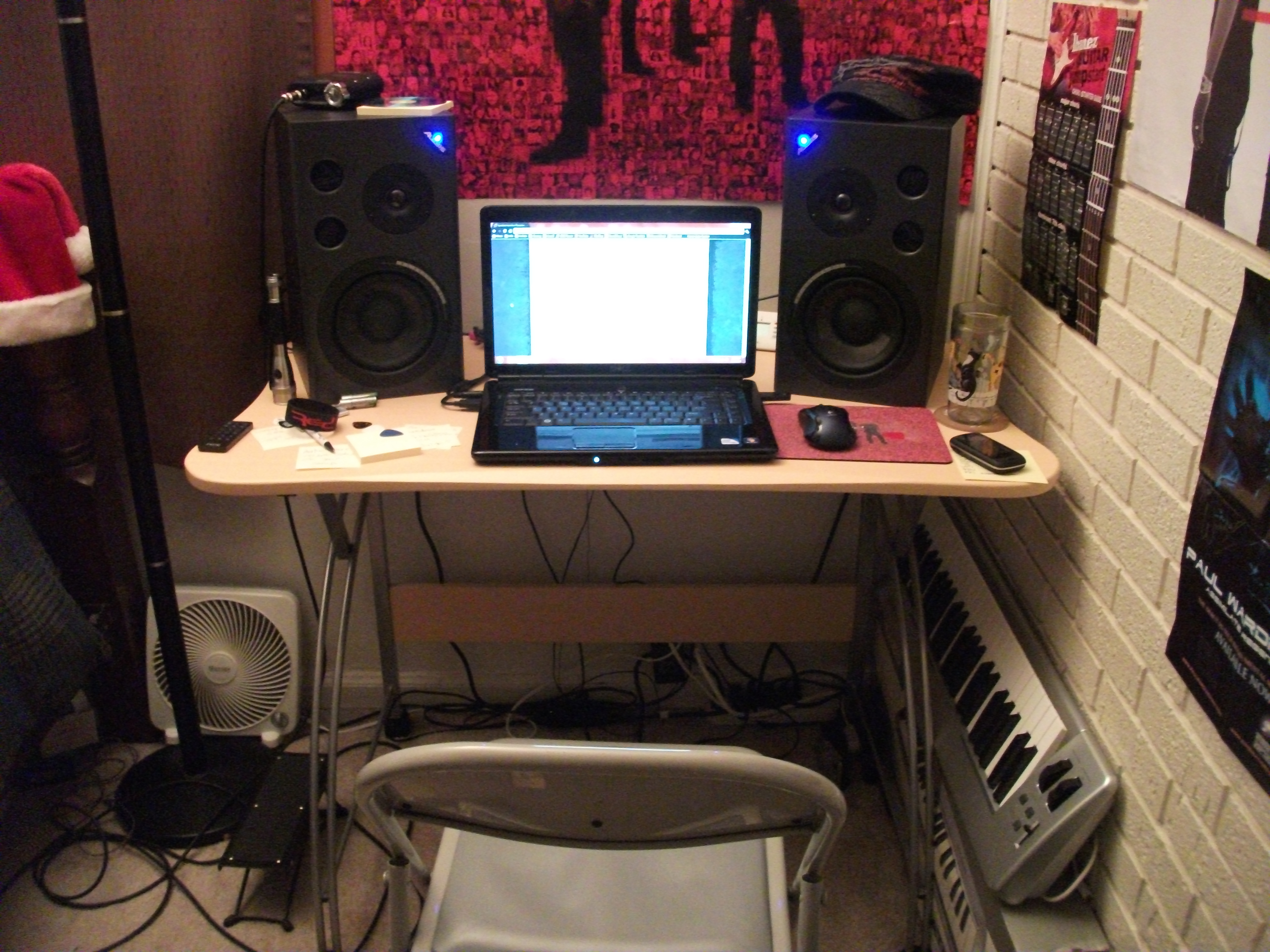
|
|
|
||
|
|
|
|
| Mar 15 2012, 11:57 AM |
|
Ours are positioned in free, open space so that there is nothing in front of them and the listening position. Monitors are symmetrical from the walls and about 1 1/2 meters from the rear wall and 1 meter from the back wall but there are large bass traps behind each monitor. The monitors and the listening position form the corners of an equalateral triangle. Each side of the triangle is @ 2.5 meters. Our monitors are on rigid metal stands and are at a height so that the mid point between the tweeter and the mid driver is level with my ear, with the bass speaker at the bottom. This positioning provides for the most accurate and most stable stereo representation.
Todd - if you position your speakers like you have you will get comb filtering from your monitors and the reflection will mess up the stereo timing and instrument placement. Hard to tell from your photo but the monitors do not appear to be symmetircal wrt to the side walls and it looks like there may be a window slightly off-centre behind one? If so these will again affect timing and stability of the stereo image. Also, if your monitors are not designed to be side mounted then you will get timing issues between the bass and the mid/high. Walking around the room can help as it can reveal room node issues. Ideally you should then deal with these with acoustic treatment. Another thing that is worth trying is to stand outside the room and listen to a mix for spectral balance. Once you are used to these though you should establish a proper listening position and try to stay with it. Fireball - you should move your desk out from the corner so that the monitors are equi distant and so that one of them isn't firing into a corner. Also if you can't get the speakers up off the desk surface move them forward to the edge of the desk to help reduce the combfiltering from surface reflection. -------------------- Get your music professionally mastered by anl AES registered Mastering Engineer. Contact me for Audio Mastering Services and Advice and visit our website www.miromastering.com
Be friends on facebook with us here. We use professional, mastering grade hardware in our mastering studo. Our hardware includes: Cranesong Avocet II Monitor Controller, Dangerous Music Liasion Insert Hardware Router, ATC SCM Pro Monitors, Lavry Black DA11, Prism Orpheus ADC/DAC, Gyratec Gyraf XIV Parallel Passive Mastering EQ, Great River MAQ 2NV Mastering EQ, Kush Clariphonic Parallel EQ Shelf, Maselec MLA-2 Mastering Compressor, API 2500 Mastering Compressor, Eventide Eclipse Reverb/Echo. |
|
|
||
|
|
|
|
| Mar 21 2012, 03:57 PM |
|
... I suppose it might help if I position my desk where I am facing the corner? Then speakers would then be on either side of the corner. I could try that, but I am not sure I have enough room since my bed is nearby. ... It could go either way as it would depend a lot on room construction. I'd guess though that the corner has one solid outer wall. If the other is also solid then you will get a lot of bass build up but your monitors might benefit from that as that's the way they're designed. You might however end up with too much bass. If one wall is solid and other a stud/partition wall you will get a very uneven bass response: the solid wall will absorb and resonate but the bass will pass through the stud. So your frequency spectra will be poor, stereo imaging a bit odd and you'll have timing issues as well. Only way - unless you have the eupiment to monitor and assess this - if try it and see what you think. Position the monitors and play a couple of commercial cds which have a bass response/track that you know well and see what it sounds like: if you can hear the bass notes more clearly and if the timing of the notes is ok (so that they don't smear in to each other)/ better than before then go with it. If it's worse then stay as you are. One small change you could probably do with your parents - look at fitting a small sliding shelf to the bottom of your desk and put your lap top on it. Then you can move the pseakers forwad and slide the laptop in/out as you want. With their help and permissin also thnk about how you might be able to move furniture and your bed around a bit to help with placement Your placements sounds pretty much perfect Tony These are my second pair of Near Fields so I don't use them for anything critical typically. I use the KRKs with the sub for mixing usually and these I turn on and walk around in and out of the room and let a mix just play. You are spot on with the value of listening from outside the room as well. Door open, door closed, I"ll let a mix loop and just go about my business walking in and out just to see how the mix/bass/texture sounds through the walls and such as it often helps give me a better idea of where I"m at oddly enough in terms of completing the mix to hear it with walls in between me and the speakers. I tried listening in front and stereo is wrecked, and comb filtering is quite bad. Outside of the room is about like it was before, and even iside the room walking around seems about the same, but the sweet spot is gone. I added a large 40 inch monitor / screen to my rig and did this partially to get back some desk space. I gotta say if this was my mixing set I couldn't leave it this way for long. Yeah the reflections will also be making a mess of the ghost centre/sweet spot Todd and have probably added a lot of nodes and antinodes to the room acoustics. If you don't already also check your mixes with a mono collapse as I think that will tell you a lot about how reflections are affecting the ghost centre. With the screens it might be worth thinking about wallmountng them as a way of getting them behind the monitors. You'll still get reflection but there would be less comb filtering. -------------------- Get your music professionally mastered by anl AES registered Mastering Engineer. Contact me for Audio Mastering Services and Advice and visit our website www.miromastering.com
Be friends on facebook with us here. We use professional, mastering grade hardware in our mastering studo. Our hardware includes: Cranesong Avocet II Monitor Controller, Dangerous Music Liasion Insert Hardware Router, ATC SCM Pro Monitors, Lavry Black DA11, Prism Orpheus ADC/DAC, Gyratec Gyraf XIV Parallel Passive Mastering EQ, Great River MAQ 2NV Mastering EQ, Kush Clariphonic Parallel EQ Shelf, Maselec MLA-2 Mastering Compressor, API 2500 Mastering Compressor, Eventide Eclipse Reverb/Echo. |
|
|
||
|
|
|
|
| Nov 19 2013, 12:33 AM |
|
I had to hunt down this post - it's been a while!
So I'm fortunate to have access to an "upper" room that I am remodeling into a "home studio". The dimensions are about 13 feet (US) square. There are 3 stud walls - 2 of which (the wall in this picture and the wall on the left (depicted in this picture) will be inulated using standard wall insulation - the wall on the right is not insulated and the furthest wall is a concrete wall - making this a challenge. I may end up insulating the wall on the right (a lot of work), to at least be somewhat consistent in how the waves bounce around. I'm planning on placing a desk on wheels that can be pulled away from the wall when mixing, and having the speakers aligned as Tony recommends = 1.5 meres from walls and positioned equidistant from my ears when sitting.  The ceilings will be insulated, and I'll have track ligthing and carpted floors. But wall treatment is my main concern at this point since I'll be sheet rocking this week. I'm not sure which wall would be best to be facing when mixing - should the speakers pointed away from the concrete wall, or towards the concrete wall - that is, which way should I situate myself (the room) in your opinion? Thanks!  Ours are positioned in free, open space so that there is nothing in front of them and the listening position. Monitors are symmetrical from the walls and about 1 1/2 meters from the rear wall and 1 meter from the back wall but there are large bass traps behind each monitor. The monitors and the listening position form the corners of an equalateral triangle. Each side of the triangle is @ 2.5 meters. Our monitors are on rigid metal stands and are at a height so that the mid point between the tweeter and the mid driver is level with my ear, with the bass speaker at the bottom. This positioning provides for the most accurate and most stable stereo representation. Todd - if you position your speakers like you have you will get comb filtering from your monitors and the reflection will mess up the stereo timing and instrument placement. Hard to tell from your photo but the monitors do not appear to be symmetircal wrt to the side walls and it looks like there may be a window slightly off-centre behind one? If so these will again affect timing and stability of the stereo image. Also, if your monitors are not designed to be side mounted then you will get timing issues between the bass and the mid/high. Walking around the room can help as it can reveal room node issues. Ideally you should then deal with these with acoustic treatment. Another thing that is worth trying is to stand outside the room and listen to a mix for spectral balance. Once you are used to these though you should establish a proper listening position and try to stay with it. Fireball - you should move your desk out from the corner so that the monitors are equi distant and so that one of them isn't firing into a corner. Also if you can't get the speakers up off the desk surface move them forward to the edge of the desk to help reduce the combfiltering from surface reflection. -------------------- The more I practice, the more I wish I had time to practice!
My Band Forum: http://passionfly.site/chat 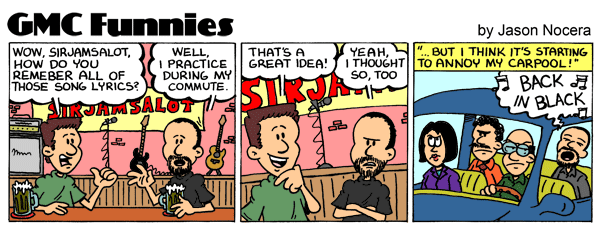 |
|
|
||
|
|
|
|
| Nov 19 2013, 06:09 PM |
|
First off congrats on building a new recording space!! Of course, this can be managed through various means as home studio folks have been doing since the dawn of the 4 track But first things first I'd suggest sending Mr. Miro a PM with a link to this thread so that he might share some of his hard won wisdom before you start your build. You may need to make some structural additions, large bass traps, etc. before you get to far in. I don't think throwing up some sound foam is gonna quite do it. But hey, the good news is you have a place to call your own to work on music. Everything else is gravy Todd Good points - The squareness of the room was a bit beyond my control, but I could put up a facade wall to un-square the room. I'll just need to get an idea of what ratio is acceptable and figure out whether it is feasible in my situation or not. Thanks Todd! -------------------- The more I practice, the more I wish I had time to practice!
My Band Forum: http://passionfly.site/chat  |
|
|
||
|
|
|
|
| Nov 20 2013, 09:49 AM |
|
This is an older thread, but just in case anyone thinks about putting their monitors like I have them in the first post above, DONT" DO IT!!
--------------------------- Onward!! Happy to help!! 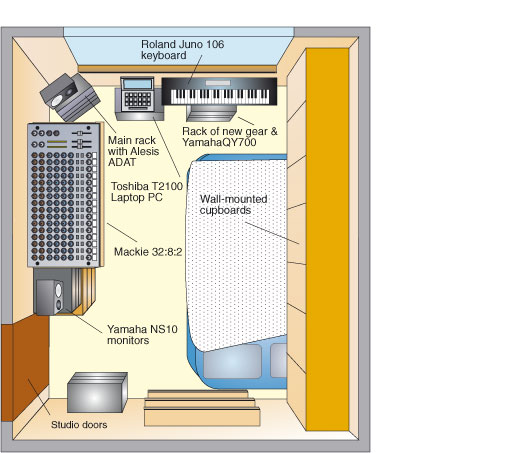 Here you can see several of the mistakes commonly made in setting up monitors in the home studio. For a start, a number of factors are compromising the stereo imaging: the speakers being on their sides, their asymmetrical placement in the room, and the insufficient angling of the drivers towards the monitoring position. Also, the right-hand speaker is placed directly in a corner of the room, while the left-hand speaker doesn't appear to be mounted on any particularly solid — both of these factors would have an impact on the bass performance. Here is a quick and dirty of a bit better plan. 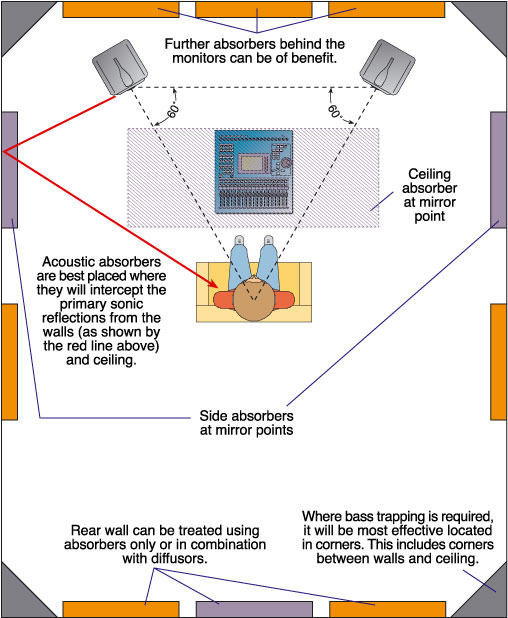 This diagram shows how to apply basic acoustic treatment to a typical home-studio room. The absorber panels shown in purple are the most important, but adding in the orange absorbers would improve the situation further. Acoustic foam is a common choice of absorber in this application. If bass trapping is required, then it is usually most effective applied in the room corners (including those corners between any of the walls and the ceiling). Note also the angles and positions of the monitors with comparison to the listening position — arranging the three points in an equilateral triangle will help give a natural stereo image. and a cross section of a bass trap design 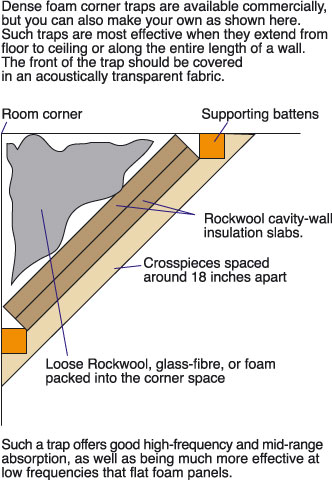 LAST BUT NOT LEAST! Here is a good article on Room Treatment/Traps/Diffusion, etc. http://www.soundonsound.com/sos/dec07/articles/acoustics.htm Good points - The squareness of the room was a bit beyond my control, but I could put up a facade wall to un-square the room. I'll just need to get an idea of what ratio is acceptable and figure out whether it is feasible in my situation or not. Thanks Todd!
This post has been edited by Todd Simpson: Nov 20 2013, 09:53 AM |
|
|
||
|
|
|
|
| Nov 20 2013, 02:19 PM |
|
Chris,
may I suggest that we discuss your build in a spearate thread? It's probably going to be require quite a few backwards and forwards responses and lots of questions, answers and discussions. In the interim a couple of quick questions, comments and suggestions from me... Preliminary questions 1/ Do you need to soundproof in order to meet any local noise regulations/not upset family or neighours, rather than just isolate the recording area to minimse bleed? Effective soundproofing, particularly if its to meet legal noise requirements, is often quite expensive and needs quite different materials than sound treatment. 2/ Is the room single purpose? Is it recording and/or mixing? 3/ If it involves recording then how many and what instruments etc would be on the sound stage? 4/ Are you happy to break th space up in separate defined areas or do you want it as a single large space? 5/ What equipment and any instruments need to be located? 6/ What are the electrics, water, lighting and aircon like? 7/ What is the floor made of? Preliminary comments Todd's post has got some good stuff in it and certainly worth the read. Also Ethan Winner has a good site about acoustic treatment for studios here. He's quite opinionated and whilst he knows his stuff not everyone agrees with everything he says but his site is still very helpful and well worth at least a quick read. Also, he has a room mode calculator which will be helpful once you know your dimensions etc :-). 1/ 13x13 isn't a great shape as it's a square. Squares are actually the worst shape as you will have big problems with reflections and standing waves. So you will need to as a minimum put in a partition to break that up. When you do you do not want to end up with a perfect regular rectangle (where one wall is a mutiple of the perpendicular one i.e.6x12). Those are better than a square but not much. A sort of ship type shape/irregular hexagon or octagon is a much better shape bit would need careful thinking to use the space you've got effectively. I'd consider at this point if you have enough room to have a small machine room. If you do then you can put your pc daw, AD/DA and anything else that can be a bit noisy/intrusive but whch you don't needs hands on all the time and so keep them out of the studio. Including a small machine room at the build stage might be cheaper than buying a rack pc and trying to soundproof and isolate it. 2/ You may need to consider the floor particularly as the room isn't on the ground so might need more consideration about vibrations etc. This means that you might have to look in to some form of resin/polymer washer/seal between the floor joists and floor covering. You might also need to double layer the floor so that a false floor floats on top of but is isolated from the actual floor. 3/ 3 stud walls and a concrete one isn't that bad. You'll have to put in at least one major stud partition though to break up the 13x13 square. You should also consider having sufficient depth between the stud and partition so that you can place some sound insolation to a depth of at least 4''. If you don't need to sound proof then the stud walls can help let frequencies escape and so reduce build up of standing waves. They also are good as you can run cabling etc thorugh them rather than having it snaking all over the floor... 4/ Corners are a pain as the bass frequencies tend to accumulate there. So these need a lot more treatment than the walls. Foam does not absorb low end effectively so you need a much better material. Most of us use mineral glass wool and I think in the US that is probably made and sold as Corning 740. The number is related to the density and it needs to be no less than 703 - 705 is better. If you use a lower density then you end up having to use increasingle more layers of it and can end up with a really thick trap that is too bulky to site. With 740 the trap still probably needs to 6'' or more in depth - less than this and you just won't trap. Glass/rock wool will sag so you need to build a frame around it to support it. The frame also makes it easier to site and move around. (Note: glass mineral wall can cause dermititis so you need to wear gloves and face mask when you handle and cut it.) 5/ Straight walls need a mix of reflection and absorption. Here you can use foam but it needs to be open cellular and not closed. It's probably easiest to buy sready made pecialised acoustic foam panels for this. 6/ You'll need ceiling clouds as well, which will need to be suspended from the roof joists. 7/ If you can have the flouescent light changed as it will almost certainly generate hum. 8/ Speaker placement is going to partly depend on the final room dimension and shape. However, if you're using 2 way mixing monitors they are probably a ported design. Ported designs nearly always need to be sited very close to the wall behind them as the wall acts to increase the bass. That wall also needs to be solid one - a stud would just let the bass escape and you'd get no help from it. So with the room design you need to remember that your monitors will probably have to have the concrete wall close behind them. Small 2 way monitors also have a requirement for you to be quite close as they often don't produce sufficient spl and volume for you sit some way away. If you sit quite a long way away th n you need to drive a small speaker really quite hard to get sufficient spl and volume. That often means they distort at either the power amp and/or spakers. Getting an ideal equilateral triangle between you and the speakers can be compromised by a need to also get a desk/console/surface in front of you. (The need to have computer monitors, rack equipment and studio furniture don't help either.) Often you end up having to compromise and accept that you just won't end up with an ideal stereo. To be honest very, very few mixing and recording studios have their monitors placed ideally. We usually achieve this in mastering partly because we don't need the big console and tons of outboar but even then I know quite a few mastering engineers/studios who accept a non-ideal stereo as a consequence of their room and other things. Monitors should fire down the longest length of the room. So the rear and facing wall - and consequently your concrete wall - need to be the narrow ones. They should also be set symmetrical from the rear and side walls. Again all of this limits where you put them, how you dimension the room and so on and ultimately you might end up having to live with a bit of a compromise. Oh and I wouldn't plan on soffit mounting them in to a wall. I don't think there is enough space here to really warrant it and you'd have to use a solid wall to do it - messy and expensive and limits up any future upgrade. To be honest I also don't think the normal 2 ways in most home studios are of a high enough quality to merit it. 9/ If the mix room is separated from the sound stage you may need to put a glass window and door between them. The window will need to be double, or better still triple, glazed and ideally use glass that minimise reflections. You can buy glass that is specialist for studios but it is really quite expensive. It's a lot cheaper, although not as good, to use a drop down persian blind or heavy curtains. Doors ideally should be the sort of air lock type construction and well sealed to the floor. 10/ You should think about how you are going to provide talk back to the soundstage and also how you run audio cabling. If your budget allow then its worth looking into ou might want to look at looms and wall boxes to do this. 11/ Cabling - try to use balanced connections and cables throughout. If you can use a multicore, coloured loom as the colours help you know which connector is which and the loom helps keep things neat and tidy. Audio cables ideally should not run parallel to electric cables or you can getinduced hum. Different types of cable have different maximum distances that you can run them before you get appreciable signal loss etc. 12/ If you have some outboard and a few mics consider a patch bay for the control room. It will make connecting and unconnecting stuff a lot simpler and save you trying to access the back of stuff that's racked. If you have, or plan on getting hardware outboard like eqs and compressors etc then you should plan to put them in to proper racks. If you can think about using a floor mounted one on wheels. That way you can put it out of the way if you're not using and so hopefully help minimise comb filtiering and reflections from them. If you do need the equipment sited so that all the controls are easyily to hand then consider having racks that are set in to a desk at an angle rather than just sit them on top. Also consider building some studio furniture at this point if you have the time and budget. Most people use computer desks but to be honest they're not great places to put a console etc. ------------------------ Great project Chris and I wish you lots of luck with it. I'lll try and help offer opinion as much as I can. If you post something youwant me to look at nudge me and I'll try and respond asap :-). -------------------- Get your music professionally mastered by anl AES registered Mastering Engineer. Contact me for Audio Mastering Services and Advice and visit our website www.miromastering.com
Be friends on facebook with us here. We use professional, mastering grade hardware in our mastering studo. Our hardware includes: Cranesong Avocet II Monitor Controller, Dangerous Music Liasion Insert Hardware Router, ATC SCM Pro Monitors, Lavry Black DA11, Prism Orpheus ADC/DAC, Gyratec Gyraf XIV Parallel Passive Mastering EQ, Great River MAQ 2NV Mastering EQ, Kush Clariphonic Parallel EQ Shelf, Maselec MLA-2 Mastering Compressor, API 2500 Mastering Compressor, Eventide Eclipse Reverb/Echo. |
|
|
||
1 User(s) are reading this topic (1 Guests and 0 Anonymous Users)
0 Members:









